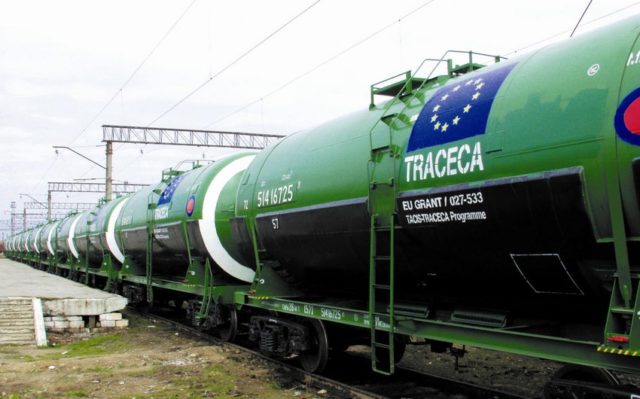
Optimization Efforts to Improve Transit Through the Critical Middle Corridor
Publication: Eurasia Daily Monitor Volume: 19 Issue: 119
By:

The Russian-Ukrainian war and Western sanctions against Moscow have limited the effectiveness of Russia as a transit country, especially in land-based trade relations between the European Union and China. In this context, the Middle Corridor (Trans-Caspian International Transport Route) has attracted increased attention from companies and governments in China, the EU and the wider region as a potential alternate route for rail trade. (see EDM, April 19, 20).
Since the war began, the Middle Corridor has experienced a huge increase in transportation volume. From January to March 2022, 266,300 tons of cargo, which is 123 percent more than the same period in 2021, transited through this route. Container traffic amounted to the equivalent of 5,847 20-foot containers (TEU)—19 percent more than between January and March 2021 (AzerNews, April 14). Although the Middle Corridor currently accounts for 3–5 percent of the total cargo volume for China-EU rail trade, an expectation is gaining traction that around 10 percent of that volume could easily be transported through the corridor (Report.az, April 6).
Despite the increasing importance of the Middle Corridor as a potential route to compensate for the relatively significant losses of the Northern Corridor, which passes through Russia, different challenges hinder the efficient use of the alternate passageway. To begin with, problems persist with the Central Asian part of the route, especially congestion issues and inefficient border controls on the Chinese-Kazakhstani border (Tengrinews.kz, January 11). Challenges at the border cause delays and increase the cost of transporting cargo, reducing the route’s reliability.
Another key dilemma regards the Caspian Sea and Black Sea portions of the route. Limited port capacities and ferry crossings have emerged as the most consequential problems. As a result, these challenges cause delays and make it difficult to accurately manage arrival times (Eurasianet, June 2).
The final problem involves rail route and traffic issues with the part of the corridor that passes through Turkey. Particularly, limited capacity in the Greater Istanbul area, especially at Halkali Station, prevents efficient transportation and causes bottlenecks, as well as more uncertainty in establishing delivery times (Rail Turkey, September 9, 2019).
As a result, national governments and local companies are working together to solve these challenges and effectively optimize transportation through the Middle Corridor. First, in terms of hard infrastructure, China and Kazakhstan’s decision to build a third border railway due to the rising demand for rail transport, as well as the completion of the second stage of the multifunctional freight terminal at Dostyk Station, are key developments that should strengthen the corridor’s efficiency and capacity. The new terminal at Dostyk could increase cargo capacity from 160,000 to 320,000 TEU per year. (Global Times, July 7; PTC Holding, May 21).
In terms of soft infrastructure, to solve border control issues and create an efficient customs control regime on the Chinese-Kazakhstani border, the Partnership Program of Customs-Railway Operators for Promoting the Safety and Rapid Customs Clearance of China Railway Express (PPCR) has initiated trial operations at Alashankou Port and Khorgos Port (Scio.gov.cn, May 25). The new operations should reduce corruption and the informal costs of cargo delivery, strengthen transparency, as well as facilitate productive customs clearance, which in turn will improve the corridor’s accuracy in estimating arrival dates.
Second, new developments in the Caspian Sea and Black Sea will further optimize transit through the Middle Corridor. The announcement of a new roll-on/roll-off (Ro-Ro) terminal, as well as the construction of a new fertilizer terminal with an annual handling capacity of 2.5 million tons at Baku International Sea Trade Port, are crucial improvements for strengthening multimodal transportation through the Caspian Sea. Both projects will reduce bottleneck problems, increase the Port of Baku’s capacity and attract more cargo (Trend.az, July 15, 18).
On the point of soft infrastructure, Azerbaijan’s decision to establish a unified center for transit freight management should promote the simplification and digitalization of border crossing procedures, reduce costs, as well as improve synchronized planning and management of transit operations from Baku Port through border areas (AzerNews, July 22).
The Azerbaijan Railway Company’s decision to add a second vessel to transport goods through the Black Sea from the Port of Batumi to the Port of Constanta, and vice versa, is another critical measure. This can increase capacity and ensure the integrity of supply chains through the Middle Corridor (Adycontainer.com, June 21).
Finally, new optimization efforts are underway for the development of the Turkish part of the corridor, which plays a central role in handling cargo moving into southern Europe. To this end, the completion of the Halkalı-Kapikule railway project this year, which is part of a high-speed railway link from Istanbul to the border with Bulgaria, will play a key role in facilitating sustainable, fast and efficient transportation through the Middle Corridor (AzerNews, June 9). Furthermore, a newly established quadrilateral coordination council among Turkey, Bulgaria, Serbia and Hungary for joint investment and improving cargo capacity and infrastructure will be critical for the optimization of the portion of the route passing through southern Europe (Railtarget.cz, July 11).
In sum, despite the current challenges in using the Middle Corridor, states and companies are beginning to direct their attention to optimizing the corridor for future transit. In the short term, growing cooperation among Middle Corridor countries and companies will help improve railways, ports and soft infrastructure; increase the corridor’s capacity; and develop fast transportation to strengthen sustainability and efficiency for increased trade. As a result, these improvements could lead to more cargo volumes being re-routed from the Northern Corridor to the Middle Corridor, especially with Chinese-EU trade. While the Middle Corridor will not provide an exhaustive alternative to the Northern Corridor in the near future, optimization efforts will increase the corridor’s potential to effectively offset losses from the Northern Corridor and reduce reliance on the Russian route in long term.



